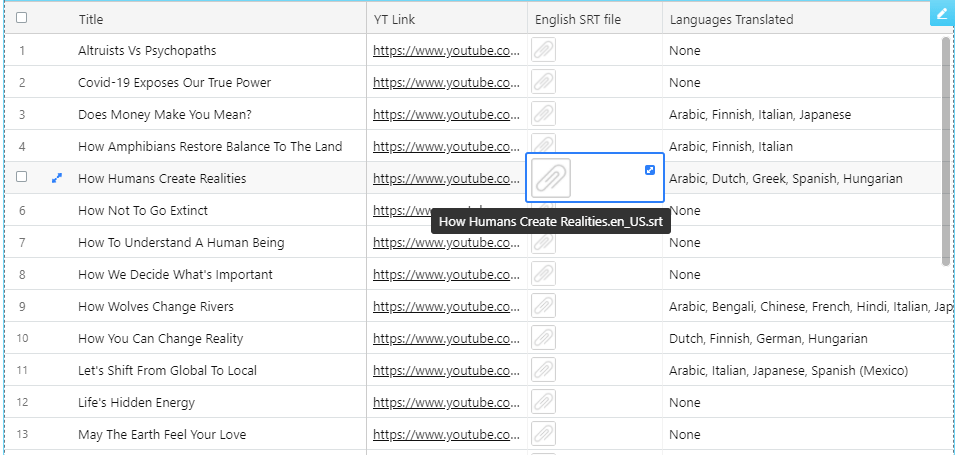
Can humanity end war forever? The new science of peace systems highlights the key ingredients for creating sustainable peace among societies.

In “How Humans Create Reality,” historian Greg Anderson invites us to reconsider what defines reality itself. He challenges the conventional view that reality is solely composed of visible, material things like atoms and mountains, suggesting that what we perceive as real is shaped significantly by cultural narratives. Anderson argues that our modern understanding of reality as predominantly material and individualistic is not universal but a construct shaped by historical circumstances specific to early modern Europe. This perspective has led us to prioritize human endeavors over the natural world, viewing non-human entities merely as resources.
Anderson contrasts our current reality with that of the classical Athenians, whose world was rich with what we would call immaterial entities like gods and spirits. In their reality, nature was a living entity intertwined with human existence, not a mere backdrop for human activity. This holistic view fostered a sense of community and interdependence starkly different from today’s individualistic society. Athenians did not see themselves as isolated individuals but as parts of a larger familial and societal organism, emphasizing collective over personal welfare.
The video delves into the implications of these differing realities on how societies function and sustain themselves. By exploring the Athenian example, Anderson illustrates that many premodern societies had sustainable ways of living that modern Western society has moved away from. He calls for a broader, more humble approach to understanding reality, suggesting that recognizing and learning from the diverse realities of other cultures is crucial for addressing the global challenges we face today. Anderson urges us to expand our imagination to conceive new ways of living that might lead to a more sustainable and equitable world, questioning whether our current path, despite its technological advances, truly serves the greater good.
In the next few minutes, I hope to change the way you think about the very nature of reality itself.
What is it that makes something real? For us, real things are material things, things made of matter that we can somehow see: like atoms, people, trees, mountains, planets. Invisible, immaterial things, like gods and demons, heavens and hells – these are considered unreal. To be real, a thing must exist objectively in some visible, material form.
What are the most important things in our real world? Answer? Human things: people, cities, societies, cultures, governments, economies. Non-human things to us are just parts of nature, a mere environment of things that we feel entitled to use however we want.
What does it mean to be a human in our real world? Well, it means being an individual, a person who lives ultimately for oneself. We think nature has made us this way, giving each and every one of us all of the reason, the rights, the freedom, and the self-interest to thrive and compete with other individuals for all of life’s important resources.
This real world of ours is neither timeless nor universal. It’s just one of countless different real worlds that humans have experienced in history.
What, then, would another world look like? Well, let’s look at one – the real world of the classical Athenians in ancient Greece. We usually know the Athenians as our cultural ancestors, but their real world was nothing like our own.
The real world of the Athenians was alive with things that we would consider immaterial and thus unreal. It pulsated with things like gods, spirits, nymphs, fates, curses, oaths, souls.
Humans did not live apart from nature. Their lives were dictated by the rhythms of the seasons and by the life cycles of crops and animals. The land of the Athenians itself was not just a piece of property or territory. It was a living goddess that had once given birth to the first Athenians and had nurtured and cared for all of their descendants ever since.
And in the real world of the Athenians, there were no individuals. All Athenians were inseparable from their families, and all Athenian families were expected to live together and work together as a single body, like cells of a living organism. They were born to serve and preserve the families and the social body that had given them life in the first place.
The whole Athenian way of being human was radically different from our own. But it has many major things in common with the real worlds experienced by numerous other premodern peoples.
In the grand scheme of history, it’s our real world, our reality that is the great exception to the rule. Only in our real world is reality itself a purely material order. Only in our real world are nonhumans always subordinate to humans. And only in our real world are humans born to be individuals.
Why this uniqueness? Well, because our real world was shaped and forged in a unique, historically unprecedented environment in early modern Europe with its scientific revolution, its enlightenment, its novel, experimental, capitalist way of life. We think our modern sciences provide the only truly objective knowledge of reality. But do they?
For more than 100 years now, the very idea of an objective reality has been seriously and continually questioned by experts in many different fields. These experts would suggest that reality is not simply a material order given to us by nature. It is something that humans actively participate in producing when their minds interact with their environments.
Different peoples have always experienced different realities, each one shaped by whatever model of the world happened to be embedded in minds and environment at the time.
We modern Westerners need to stop thinking that all premodern peoples are somehow more primitive or less enlightened than ourselves. Their real world anchored ways of life that sustained real lives for hundreds, sometimes thousands of years. Their real worlds were different. They were not wrong.
We need to be a little more humble. For all of its extraordinary technological accomplishments, our brave new modern real world has imperilled the whole future of the planet in barely 300 years. It’s made possible all manner of historical horrors.The evidence is there if you want to see it. Our model of reality has failed catastrophically in practice.
Other real worlds are possible. Let’s try to magnify our imaginations. Let’s start to imagine other possible ways of being human in other possible worlds.
 Originally from the UK, Professor Anderson holds degrees from Newcastle University, University College, London, and Yale University. He is a specialist in ancient Greek history, historical thought, and critical theory. In his research and writing, Prof. Anderson is committed to a radical historical practice, one that takes seriously the real worlds experienced by non-modern peoples, which are quite unlike our own. Humans have always lived in a “pluriverse” of many different worlds, not in a universe of just one.
Originally from the UK, Professor Anderson holds degrees from Newcastle University, University College, London, and Yale University. He is a specialist in ancient Greek history, historical thought, and critical theory. In his research and writing, Prof. Anderson is committed to a radical historical practice, one that takes seriously the real worlds experienced by non-modern peoples, which are quite unlike our own. Humans have always lived in a “pluriverse” of many different worlds, not in a universe of just one.“Yes, indeed. We must set a new civilizational goal that will reunify ourselves with nature.”
For more about the speaker, visit here.
Music:
In “How Humans Create Reality,” historian Greg Anderson invites us to reconsider what defines reality itself. He challenges the conventional view that reality is solely composed of visible, material things like atoms and mountains, suggesting that what we perceive as real is shaped significantly by cultural narratives. Anderson argues that our modern understanding of reality as predominantly material and individualistic is not universal but a construct shaped by historical circumstances specific to early modern Europe. This perspective has led us to prioritize human endeavors over the natural world, viewing non-human entities merely as resources.
Anderson contrasts our current reality with that of the classical Athenians, whose world was rich with what we would call immaterial entities like gods and spirits. In their reality, nature was a living entity intertwined with human existence, not a mere backdrop for human activity. This holistic view fostered a sense of community and interdependence starkly different from today’s individualistic society. Athenians did not see themselves as isolated individuals but as parts of a larger familial and societal organism, emphasizing collective over personal welfare.
The video delves into the implications of these differing realities on how societies function and sustain themselves. By exploring the Athenian example, Anderson illustrates that many premodern societies had sustainable ways of living that modern Western society has moved away from. He calls for a broader, more humble approach to understanding reality, suggesting that recognizing and learning from the diverse realities of other cultures is crucial for addressing the global challenges we face today. Anderson urges us to expand our imagination to conceive new ways of living that might lead to a more sustainable and equitable world, questioning whether our current path, despite its technological advances, truly serves the greater good.
In the next few minutes, I hope to change the way you think about the very nature of reality itself.
What is it that makes something real? For us, real things are material things, things made of matter that we can somehow see: like atoms, people, trees, mountains, planets. Invisible, immaterial things, like gods and demons, heavens and hells – these are considered unreal. To be real, a thing must exist objectively in some visible, material form.
What are the most important things in our real world? Answer? Human things: people, cities, societies, cultures, governments, economies. Non-human things to us are just parts of nature, a mere environment of things that we feel entitled to use however we want.
What does it mean to be a human in our real world? Well, it means being an individual, a person who lives ultimately for oneself. We think nature has made us this way, giving each and every one of us all of the reason, the rights, the freedom, and the self-interest to thrive and compete with other individuals for all of life’s important resources.
This real world of ours is neither timeless nor universal. It’s just one of countless different real worlds that humans have experienced in history.
What, then, would another world look like? Well, let’s look at one – the real world of the classical Athenians in ancient Greece. We usually know the Athenians as our cultural ancestors, but their real world was nothing like our own.
The real world of the Athenians was alive with things that we would consider immaterial and thus unreal. It pulsated with things like gods, spirits, nymphs, fates, curses, oaths, souls.
Humans did not live apart from nature. Their lives were dictated by the rhythms of the seasons and by the life cycles of crops and animals. The land of the Athenians itself was not just a piece of property or territory. It was a living goddess that had once given birth to the first Athenians and had nurtured and cared for all of their descendants ever since.
And in the real world of the Athenians, there were no individuals. All Athenians were inseparable from their families, and all Athenian families were expected to live together and work together as a single body, like cells of a living organism. They were born to serve and preserve the families and the social body that had given them life in the first place.
The whole Athenian way of being human was radically different from our own. But it has many major things in common with the real worlds experienced by numerous other premodern peoples.
In the grand scheme of history, it’s our real world, our reality that is the great exception to the rule. Only in our real world is reality itself a purely material order. Only in our real world are nonhumans always subordinate to humans. And only in our real world are humans born to be individuals.
Why this uniqueness? Well, because our real world was shaped and forged in a unique, historically unprecedented environment in early modern Europe with its scientific revolution, its enlightenment, its novel, experimental, capitalist way of life. We think our modern sciences provide the only truly objective knowledge of reality. But do they?
For more than 100 years now, the very idea of an objective reality has been seriously and continually questioned by experts in many different fields. These experts would suggest that reality is not simply a material order given to us by nature. It is something that humans actively participate in producing when their minds interact with their environments.
Different peoples have always experienced different realities, each one shaped by whatever model of the world happened to be embedded in minds and environment at the time.
We modern Westerners need to stop thinking that all premodern peoples are somehow more primitive or less enlightened than ourselves. Their real world anchored ways of life that sustained real lives for hundreds, sometimes thousands of years. Their real worlds were different. They were not wrong.
We need to be a little more humble. For all of its extraordinary technological accomplishments, our brave new modern real world has imperilled the whole future of the planet in barely 300 years. It’s made possible all manner of historical horrors.The evidence is there if you want to see it. Our model of reality has failed catastrophically in practice.
Other real worlds are possible. Let’s try to magnify our imaginations. Let’s start to imagine other possible ways of being human in other possible worlds.
“Yes, indeed. We must set a new civilizational goal that will reunify ourselves with nature.”
For more about the speaker, visit here.
Music:
Find out how video storytelling can help your audience resonate with your sustainable idea, research, campaign or product.


We never send solicitations or junk mail and we never give your address to anyone else.


